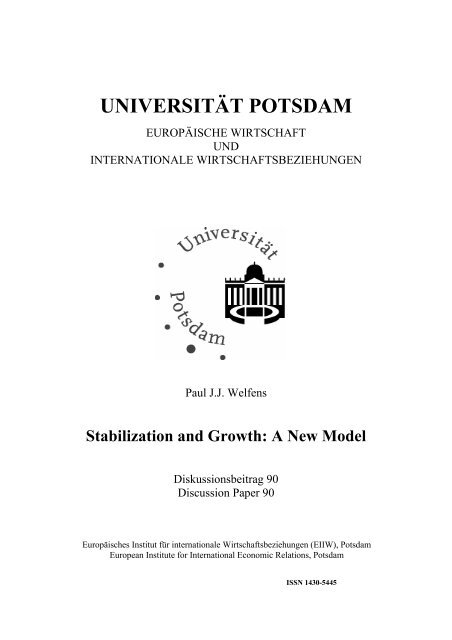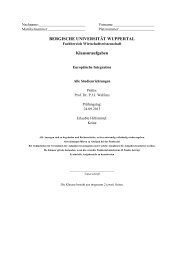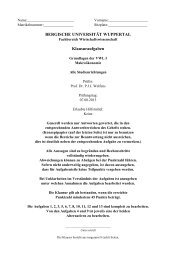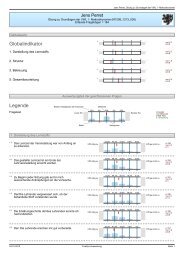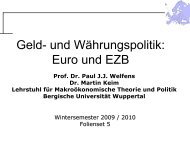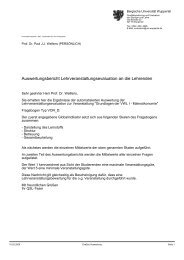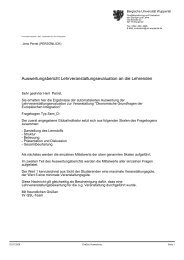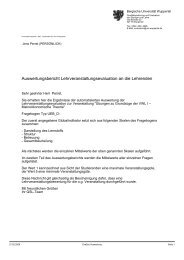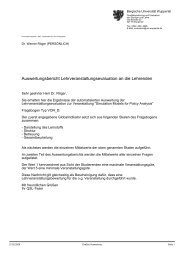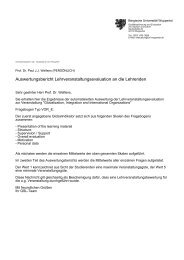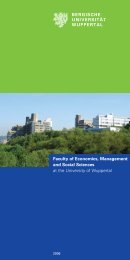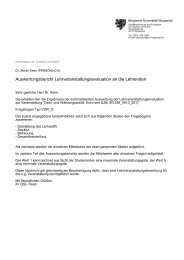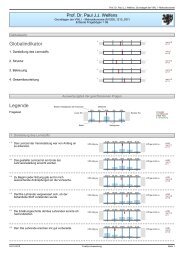UNIVERSITÄT POTSDAM - Prof. Dr. Paul JJ Welfens
UNIVERSITÄT POTSDAM - Prof. Dr. Paul JJ Welfens
UNIVERSITÄT POTSDAM - Prof. Dr. Paul JJ Welfens
You also want an ePaper? Increase the reach of your titles
YUMPU automatically turns print PDFs into web optimized ePapers that Google loves.
<strong>UNIVERSITÄT</strong> <strong>POTSDAM</strong><br />
EUROPÄISCHE WIRTSCHAFT<br />
UND<br />
INTERNATIONALE WIRTSCHAFTSBEZIEHUNGEN<br />
<strong>Paul</strong> J.J. <strong>Welfens</strong><br />
Stabilization and Growth: A New Model<br />
Diskussionsbeitrag 90<br />
Discussion Paper 90<br />
Europäisches Institut für internationale Wirtschaftsbeziehungen (EIIW), Potsdam<br />
European Institute for International Economic Relations, Potsdam<br />
ISSN 1430-5445
Diskussionsbeitrag Nr. 90<br />
Discussion Paper No. 90<br />
Europäische Wirtschaft und Internationale Wirtschaftsbeziehungen<br />
European Economy und International Economic Relations<br />
<strong>Paul</strong> J.J. <strong>Welfens</strong><br />
Stabilization and Growth: A New Model<br />
October 2001<br />
Editor: <strong>Prof</strong>. <strong>Dr</strong>. <strong>Paul</strong> J.J. <strong>Welfens</strong><br />
University of Potsdam, European Economy and International Economic Relations<br />
Karl-Marx-Str. 67, D-14482 Potsdam, Germany, Tel.: (0)331-9774614, Fax: (0)331-<br />
9774631<br />
EUROPÄISCHES INSTITUT FÜR INTERNATIONALE WIRTSCHAFTSBEZIEHUNGEN (EIIW)<br />
ISSN 1430-5445<br />
Key words: Macroeconomics, Growth, Fiscal Policy, Trade, Investment.<br />
JEL classification: C1, E1, F00, O41
<strong>Prof</strong>. <strong>Dr</strong>. <strong>Paul</strong> J.J. <strong>Welfens</strong>, Jean Monnet chair in European Economic<br />
Integration and president of European Institute for International<br />
Economic Relations (EIIW) at University of Potsdam, August-Bebel-Str.<br />
89, D 14482 Potsdam, Tel. +49 (0)331 977-4614,<br />
<strong>Welfens</strong>@rz.uni-potsdam.de<br />
www.euroeiiw.de<br />
Stabilization and Growth: A New Model<br />
1. Introduction ………………………………………………………………………….1<br />
2. Growth Theory and Medium-term Macroeconomic Analysis ………………………2<br />
2.1. Investment Theory and Empirical Analysis for<br />
the US and Germany ………………………………………………………………2<br />
2.2. Stationary Economy………………………………………………………………..6<br />
2.3. Growing Economy..………………………………………………………………11<br />
3. Conclusions ...………………………………………………………………………15<br />
References.…………………………………………………………………………….17<br />
I am grateful for discussions with Albrecht Kauffmann and Andre Jungmittag, EIIW at<br />
the University of Potsdam; and to Manfred Kremer, ECB. I also have benefited from<br />
my research at AICGS/The Johns Hopkins University<br />
The usual disclaimer applies<br />
Publication of this paper has been made possible by financial support of a major<br />
central bank in Europe; this is the first paper in our special series:<br />
Monetary and Real Aspects of European Integration and Globalization
Summary<br />
This paper shows a way to integrate Keynesian macroeconomic analysis and growth<br />
modeling. Within a medium term model – with forward-looking investors – we present<br />
an approach which combines macro analysis and (modified) neoclassical growth<br />
modeling. The fiscal multiplier can be higher or lower than the familiar expression<br />
from the Mundell-Fleming model; the multiplier can even be negative. We highlight<br />
the dual nature of the savings rate and suggest finally some possible extensions for<br />
future research.<br />
Zusammenfassung<br />
Dieser Beitrag zeigt einen neuen Weg, um Keynesianische Makroanalyse und<br />
Wachstumsmodellierung miteinander zu verbinden. Im Rahmen eines mittelfristigen<br />
Modells – mit vorwärts schauenden Investoren – präsentieren wir einen Ansatz, der die<br />
Makroanalyse mit einem (modifizierten) neoklassischen Modell verbindet. Der<br />
Fiskalmultiplikator kann größer oder kleiner sein als im herkömmlichen Mundell-<br />
Fleming-Modell, sogar ein negativer Multiplikator ist denkbar. Die doppelte und<br />
uneindeutige Rolle der Sparquote wird aufgezeigt, zudem werden Ideen für weitere<br />
Modellanalysen vorgeschlagen.
1. Introduction<br />
In economic analysis there is a rather strict dichotomy between business cycle analysis<br />
– often cast within the Mundell-Fleming approach – and growth theory. However, in<br />
reality, short term macroeconomic changes and growth trends are overlapping<br />
phenomena. Therefore it could be useful to model both phenomena in a consistent<br />
integrated framework. Standard contributions in the field of integrating cyclical aspects<br />
and growth aspects within the literature are the model from PHILLIPS (1961) and<br />
GOODWIN (1965); OBSTFELD (2001) gives a survey on progress in international<br />
macroeconomics (“Beyond the Mundell-Fleming Model”), important contributions<br />
along the lines of optimal growth theory for open economies came from BARDHAN<br />
(1967), HAMADA (1969), and BRUNO (1970). While these approaches have their<br />
merits the old problem of bridging short-term Keynesian analysis and growth theory<br />
has not been solved.<br />
A typical question in macroeconomics concerns the role of fiscal and monetary<br />
policy. In particular the role of fiscal policy has been debated. In a simple<br />
macroeconomic model a rise of government consumption G raises real income Y so<br />
that consumption is raised; if government is financing additional expenditures via<br />
bonds there is some risk of crowding out private investment demand in the case that the<br />
real interest rate is rising. The standard Keynesian model is unusual in the sense that we<br />
are not informed whether the increase in G occurs in an economy which is growing or<br />
in an economy which is stationary.<br />
In the following analysis we will argue that forward-looking investors will take<br />
into account this issue: They will anticipate the future steady-state per capita income in<br />
a stationary economy; and in a growing economy they will take into account both the<br />
long term level of the growth path and the growth rate itself. In such a setting we can<br />
take into account the double role of the savings rate in a consistent way: In the<br />
Keynesian macro model a high savings rate generates a small output multiplier; by<br />
contrast, growth theory shows a positive impact of the savings rate on the level of the<br />
growth path. In the model proposed we combine both aspects and identify a critical<br />
savings rate s’– below the fiscal multiplier is negative, above the critical savings rate it<br />
is positive (and the positive multiplier falls with s).<br />
It will be emphasized that investors – even in an economy with temporary<br />
underutilization of capacity – are forward-looking in their decision-making.<br />
Neoclassical investment theory and empirical findings for the investment output ratio<br />
support the approach suggested here.<br />
On the bottom line our analysis suggests new ways to analyze issues of cyclical<br />
development in market economies. With respect to economic policy government must<br />
carefully decide whether it prefers a short term expansion of government consumption<br />
or to adopt measure which raise anticipated steady state variables (level of growth path,<br />
1
or growth rate itself). The model also implicitly suggests that a distinction between<br />
government consumption and government investment is quite important.<br />
The paper is organized as follows: At first we will take a brief look at<br />
investment theory and also take a closer look at the empirical results for the US and<br />
Germany. Then we turn to the theoretical case of a stationary economy with forwardlooking<br />
investors who will anticipate the steady state results; here we merge the<br />
traditional macro model and growth theory in a straightforward way. Then we take a<br />
look at the case of growing economy where both exogenous growth and endogenous<br />
growth can be considered. Finally, we draw some conclusions.<br />
2. Combining Growth Theory and Medium-term Macroeconomic<br />
Analysis<br />
2.1 Investment Theory and Empirical Analysis for the US and Germany<br />
In the following analysis we consider a simple framework in which investors are<br />
rational decision-makers; output is determined by a Cobb-Douglas function with<br />
Horrod-neutral progress: Y=K ß (AL) 1-ß . Gross investment I is the sum of optimal net<br />
investment dK#/dt plus depreciation.<br />
(i) I = dK#/dt + δK<br />
With the Cobb Douglas production function we have ∂Y/∂K=ßY/K; profit<br />
maximization requires (r+δ) = ß(Y/K), and at a given expected real interest rate (this<br />
might be interpreted as the natural real interest rate which is stationary in the long run<br />
in the OECD) we therefore have dK#/dt =[ß/(r+δ)]dY/dt which results in optimum<br />
gross investment being equal to:<br />
(ii) I = [ß/(r+δ)]dY/dt + δY (1/ß) /(AL) (1--ß)/ß<br />
Dividing by Y and using the symbol y‘=Y/(AL) we obtain:<br />
(iii) I/Y = [ß/(r+δ)]gY + δ y‘ (1--ß)/ß<br />
2
Hence the investment output ratio is a negative function of r and a positive function of<br />
the growth rate of output and of the ratio Y/(AL).<br />
If in reality there are adjustment costs we can use a more realistic investment<br />
function – with an adjustment parameter: investment in period t is investment of the<br />
previous period plus an adjustment factor which is proportionate to the difference<br />
between optimum investment and investment in the previous period. Optimum<br />
investment is determined as in equation (ii) and (iii), respectively.<br />
It = It-1 + λ(It# - It-1) + δK = λIt# + (1-λ)It-1+ δK<br />
Such an approach was empirically tested for Germany and the US. We used<br />
annual data for Germany, 1972-99): It / It-1=(It*/ It-1) ζ . We use a dummy variable with<br />
D=1 for 1994 when the reunited Germany had an investment boom due to<br />
reunification; in all other years D=0; and we have a normally distributed error term U<br />
in the logarithmically specified investment function.<br />
ln I= ζ ln It-1 +lnb+ φln(1+rt-1) + εgY + θlnY/L + ξD+U<br />
Results for USA<br />
As regards the empirical results for the US in the period 1972–99 the investment output<br />
ratio (IQ_U) significantly depends on:<br />
• lagged investment output ratio (IQ_U(-1))<br />
• growth rate of real income (GY_U)<br />
• level of per capita income (YPC_U)<br />
• lagged (by one year) real interest rate (long term interest rate minus<br />
inflation rate, R_U(-1)).<br />
The test statistics are quite satisfactory.<br />
3
4<br />
Dependent Variable: LOG(IQ_U)<br />
Method: Least Squares<br />
Date: 01/30/02 Time: 14:49<br />
Sample(adjusted): 1973 1999<br />
Included observations: 27 after adjusting endpoints<br />
Variable Coefficient Std. Error t-Statistic Prob.<br />
C -0.550039 0.215238 -2.555492 0.0180<br />
LOG(IQ_U(-1)) 0.920949 0.082838 11.11748 0.0000<br />
GY_U 0.031049 0.004001 7.760834 0.0000<br />
LOG(YPC_U) 0.120200 0.073713 1.630647 0.1172<br />
LOG(1+R_U(-1)) -0.679036 0.304985 -2.226459 0.0365<br />
R-squared 0.884941 Mean dependent var -1.658063<br />
Adjusted R-squared 0.864021 S.D. dependent var 0.101567<br />
S.E. of regression 0.037453 Akaike info criterion -3.565878<br />
Sum squared resid 0.030860 Schwarz criterion -3.325908<br />
Log likelihood 53.13935 F-statistic 42.30153<br />
Durbin-Watson stat 1.942696 Prob(F-statistic) 0.000000
Empirical Results for Germany<br />
The picture for Germany is similar to the US, the lag structure slightly differs. All<br />
variables are highly significant and the Durbin Watson statistic is satisfactory. Iq_G is<br />
investment GDP ratio, Germany The lagged investment output ratio and the real<br />
interest rate variable show relatively large coefficients, the coefficient for per capita<br />
income is 0.06, the coefficient for the growth rate of output is 0.002.<br />
GY_G is growth of real GDP; YPC_G Per capita income<br />
R_G real interest rate<br />
Dependent Variable: LOG(IQ_G)<br />
Method: Least Squares<br />
Date: 12/05/01 Time: 17:48<br />
Sample(adjusted): 1973 1999<br />
Included observations: 27 after adjusting endpoints<br />
Variable Coefficient Std. Error t-Statistic Prob.<br />
C -1.099276 0.218467 -5.031774 0.0000<br />
LOG(IQ_G(-1)) 0.552913 0.087420 6.324823 0.0000<br />
GY_G 0.017731 0.002382 7.444623 0.0000<br />
LOG(YPC_G) 0.129929 0.060921 2.132734 0.0444<br />
LOG(1+R_G) -2.454491 0.668044 -3.674147 0.0013<br />
R-squared 0.842550 Mean dependent var -1.547979<br />
Adjusted R-squared 0.813923 S.D. dependent var 0.066318<br />
S.E. of regression 0.028607 Akaike info criterion -4.104725<br />
Sum squared resid 0.018004 Schwarz criterion -3.864756<br />
Log likelihood 60.41379 F-statistic 29.43183<br />
Durbin-Watson stat 1.825568 Prob(F-statistic) 0.000000<br />
5
2.2 Stationary Economy<br />
Neoclassical growth theory (JONES, 1998) is rather solid body of knowledge. It<br />
assumes that savings will determine gross investment and that a steady state value for<br />
capital intensity K/L (K and L stand for capital and labor/population, respectively). If<br />
one uses a Cobb-Douglas production (0
This implies that capital intensity k#=K/L and per capita output (y#) in<br />
equilibrium are given by:<br />
(4b) k# = Aoe at [[s(1-τ)]/(n+a+δ)] 1/(1-ß)<br />
(4c) y# = Aoe at [[s(1-τ)]/(n+a+δ)] ß/(1-ß)<br />
We now turn to the familiar Keynesian system in which effective demand<br />
determines output Y. An important point in the following approach of merging the<br />
Keynesian system with a growth model is the investment function.<br />
It has been shown for an economy with proportionate capital deprecation that<br />
neoclassical profit maximization leads – with gY denoting the growth rate of output - to<br />
an investment output ratio z which is given by<br />
(5a) z = z(r, y’, gY)<br />
The investment output ratio negatively depends on the real interest rate r; z<br />
depends positively on y’=Y/(AL) because reinvestment depends on k’ (k in an<br />
economy with zero Harrod-neutral progress) which in turn is equivalent to a certain per<br />
capita income figure (Y/L in a model with A=1, otherwise Y/(AL)) in a full<br />
employment economy. In the context of a medium term model it is obvious that profitmaximizing,<br />
forward looking investors will take into account the long term growth rate<br />
of output which is exogenous in the neoclassical model – but endogenized in the New<br />
Growth Theory. The higher the anticipated steady state values of y and gY, the higher<br />
the level of investment. From this perspective the question arises whether government<br />
policy not only affects short term aggregate demand and output, respectively, but also<br />
the long term (steady state) values of y and gY, respectively. The traditional IS-LM<br />
model completely ignores this issue.<br />
Empirical analysis for Germany and the US supports the approach chosen here.<br />
Hence we have for gross investment<br />
(5b) I = z(r,y’,gY) Y<br />
We will assume a linear function for the investment output ratio, namely:<br />
(5c) I/Y = {[b/r] +hy’ +vgY}; b, h, v>0<br />
7
In a situation of unemployment – if labor demand L exceeds exogenous labor supply<br />
N’ – one could use a modified investment function which reflects the hypothesis that<br />
the investment-output ratio will be reduced in the presence of (temporary)<br />
unemployment; I/Y would reduce proportionate to L-N’. We will ignore this aspect<br />
here and rather focus on investment function (5c): Therefore the familiar goods market<br />
equilibrium condition can be written for the case of a small open economy (and with *<br />
for foreign variables) as:<br />
(6) Y = C(Y,τ) + G + z(r, y’, gY)Y + [X(q*,Y*)-q*J(q*,Y)]<br />
Consumption is assumed to depend on real income Y and the income tax rate τ,<br />
government consumption is exogenous, investment is as given by (5b) and the current<br />
account by a standard export function and import function – with q* denoting the real<br />
exchange rate eP*/P. Chosing a linear specification for z(...) and standard export<br />
function X =x(q*)Y* and import function J=j(q*)Y we have:<br />
(7a) Y = cY(1-τ) + G + {[b/r] +hy’ +vgY}Y + [x(q*)Y* -q*j(q*)Y]<br />
It is quite implausible to assume – as it is done in the standard Keynesian model - that<br />
investors are not forward-looking in their decisions and thus ignore the long term per<br />
capita income level or the growth rate. We therefore consider equation (7a) as a<br />
consistent medium term approach, and we will argue that quasi-rational investors –<br />
which are forward-looking - will take long term y and gY from the growth model. In a<br />
growth approach with technological progress being zero, the setup comes close to the<br />
standard Keynesian model. Therefore we will initially use a combination of this special<br />
case of the growth model with the Keynesian macro approach. As we argue that<br />
investors will anticipate the long term steady state solution, we implicitly assume that<br />
investors are not living in a “super-Keynesian” environment which would never again<br />
reach a steady state of an equilibrium under profit maximization. The way steady state<br />
is defined is slightly different from the standard notion in growth theory, which<br />
assumes full employment in the steady state; here it is emphasized that “equilibrium<br />
unemployment” u can occur in a growth model, and it is easy to show that the<br />
assumption of a zero savings rate for the unemployed will lead in a model without<br />
technological progress – with s being the savings rate of workers –in the long run to<br />
steady state per capita worker output: y#:=[[s(1-τ)] (1-u)/(n+δ)] ß/(1-ß) . In the following<br />
we will not assume long term unemployment.<br />
8
For the simple case of a stationary economy without population growth (a=0,<br />
n=0) the long term equilibrium per capita income is given by:<br />
(8) y#= ([s(1-τ)]/δ) ß/(1-ß)<br />
Assuming that investors anticipate the steady state value y# (and gY=0 in the steady<br />
state) we can replace y in equation (7a) and get:<br />
(7a‘) Y = cY(1-τ) + G + {[b/r] +h[(s(1-τ)/δ) ß/(1-ß) ]}Y + [x(q*)Y* -q*jY]<br />
Note that in r-Y-space our medium term ISK curve (portraying equation 7a’) is steeper<br />
than the standard IS curve – if we set h=0 and assume that dr/dY>0. This would also<br />
have implications for monetary policy which, however, will not be considered here;<br />
rather we will assume that the (long term) interest rate is given – or the interest<br />
elasticity of the demand for money is infinity.<br />
The fiscal multiplier clearly differs from the standard multiplier, and it is also<br />
interesting to see the more complex role of the savings rate we now have: It is true that<br />
a high savings rate implies a priori a small fiscal policy multiplier – according to the<br />
standard IS-LM result -, but our approach also takes into account the anticipated effect<br />
of s and the investment-output ratio, respectively, on the steady state. To highlight this<br />
aspect assume that b=0 and j=0 or that q*j-(b/r)=0; moreover, we assume ß=1/3 which<br />
is rather realistic for OECD countries. For a given real interest rate r, the multiplier for<br />
expansionary fiscal policy (dG>0) is no longer the familiar multiplier 1/[[s(1τ)+τ+q*j];<br />
rather we have<br />
(8a) dY/dG = 1/{[s(1-τ)+τ] – h(s[1-τ]/δ) 1/2 }<br />
The denominator is negative if<br />
(9a) s(1-τ)+τ >h[s(1-τ)]/δ) 1/2<br />
(9b) [s(1-τ)+τ] 2 >h 2 s(1–τ)/δ<br />
(9c) s(1–τ)+2τ+τ 2 /(s(1–τ))> h 2 /δ<br />
9
If we assume for simplicity that τ is rather small, so that τ 2 approaches zero, we<br />
have a straightforward critical value s’:<br />
(10) s’ = (h 2 /δ–2τ)/(1-τ)<br />
If the savings rate s is slightly larger than s’ we have a positive multiplier, if s is<br />
slightly smaller the fiscal multiplier is negative (see figure 1):<br />
Fig. 1: Fiscal Multiplier in Growth-Oriented Macro Model<br />
10<br />
dY/dG<br />
0<br />
s‘<br />
We thus have an interesting empirical issue. Moreover, if s should rise in poor societies<br />
along with y until a certain value y## has been reached - with s falling if y>y## - there<br />
are two aspects of interest: In a situation of relatively low y we will have negative fiscal<br />
multipliers.<br />
The more general multiplier expression for a stationary economy is:<br />
(8b) dY/dG = 1/{[s(1-τ)+τ]+q*j - (b/r) -h[[s(1-τ)]/δ) ß/(1-ß) ]}<br />
s
It no longer holds that the smaller s is the larger is the multiplier (the standard case in<br />
the Keynesian macro model), rather, that once we are below a critical savings rate s’,<br />
the case may occur that the multiplier becomes negative. One may note that h could<br />
indeed be equal to the depreciation rate. On the bottom line the crucial point to make is<br />
that our medium term model suggests different fiscal multipliers to standard analysis.<br />
Moreover, the savings rate has an ambiguous effect:<br />
2.3 Growing Economy<br />
For considering a growing economy – with the progress rate a>0 - equation (7) can be<br />
divided by AL so that we have under the assumption that A*L*=AL (and with G’<br />
denoting G/(AL)): The ISK curve now can be drawn in an r-y’ diagram.<br />
(7a) y’ = c(1-τ)y’ + G’ + {[b/r] +h([s(1-τ)]/δ) ß/(1-ß) +va}y’ + [x(q*)y’* -q*j(q*)y’]<br />
The ISK curve has a negative slope if s(1-τ) -{[b/r] +h([s(1-τ)]/δ) ß/(1-ß) +va}>0. The<br />
fiscal multiplier now is<br />
dy’/dG’=dY/dG =1/{[s(1-τ)+τ]+q*j - (b/r) -h[[s(1-τ)]/δ) ß/(1-ß) ] -va}<br />
Again, this multiplier can be positive or negative; if it is positive it holds that<br />
the larger the steady state growth rate is, the larger the multiplier effect. The smaller the<br />
real interest rate the larger the multiplier provided it is positive.<br />
A more complex and interesting case of a growing economy is one in which<br />
technological progress is endogenized. If we take into account a hybrid growth model<br />
(WELFENS, 2002) the long term growth rate is determined by the export ratios at<br />
home (x in country I) and abroad (x*), by the ratio of researchers (R) to total<br />
population (L) and by a deprecation rate for technological progress as well as<br />
exponential parameters. The progress rate is assumed here to depend positively on the<br />
export-GDP ratio at home and abroad; import competition has indeed significantly<br />
contributed to technological progress in the US (MANN, 1998); for Sweden there also<br />
exists positive evidence about the link between openness and total factor productivity<br />
(ANDERSSON, 2001). Moreover the ratio of researcher to total population is also<br />
assumed to contribute to a rise of the progress rate which is assume to be subject to a<br />
kind of depreciation effect (parameter µ)<br />
11
(A.I) da/dt = {[(X/Y)(X*/Y*)] θ (R/L) ω }a Ω - µa<br />
We assume positive exponential parameters and in particular 0
(11) y’=c(1-τ)y’+G’+{[b/r]+h[[s(1-τ)]/(n+δ] ß/(1-ß) +<br />
v{[[xj] θ (R/L) ω ]/µ} 1/(Ω) }y’+[x(q*)y’*-q*jy’]<br />
Therefore the multiplier expression is given by:<br />
(12) dY/dG =1/([s(1-τ)]+jq*-[h[s(1-τ)]/[{[xj] θ (R/L) ω ]/µ} 1/(1-Ω) +δ] ß/(1-ß) ] +<br />
v{[[xj] θ (R/L) ω ]/µ} 1/(1-Ω) )<br />
The following graphs shows the IS and the ISK curve the case of the stationary<br />
case (a) and expansionary fiscal policy in a growing economy (b), respectively.<br />
Fig. 2: Growth-Oriented Macroeconomic Model<br />
r<br />
a) Stationary Case b) Fiscal Policy in the Case of<br />
Growing Economy<br />
IS 0<br />
ISK 0<br />
0 y# y<br />
y 0<br />
E F<br />
r 0<br />
r<br />
0<br />
ISK 0<br />
ISK 1<br />
LMK 0<br />
y‘ 0 y‘ 1 y# y‘=Y/AL<br />
If one assumes that G can actually be split into G C – for government<br />
consumption – and G R – for hiring researchers one can see the real challenge of fiscal<br />
policy. The structure of fiscal policy become decisive:<br />
13
14<br />
• Expansionary fiscal policy which raises government consumption might<br />
raise the level of the growth path; however, there also could be<br />
parameter constellations which lead to a negative multiplier.<br />
• Fiscal policy as growth policy, namely financing a higher number of<br />
researchers relative to population, will affect – in our model – the<br />
growth rate of output positively.<br />
This may suggest that fiscal policy as growth policy should be more emphasized than<br />
traditional fiscal policy in the form of higher government consumption. If the fiscal<br />
multiplier for government consumption is positive, the question of optimum fiscal<br />
policies arises in a new way as – depending on the time horizon of government (and<br />
potential lags for fiscal and growth policies, respectively) – government eager to raise<br />
per capita output as much as possible until a given point in time, say election day, will<br />
have to focus on the optimum policy mix in the sense of raising G C and G R at the same<br />
time while taking into account economic/institutional financing constraints.<br />
Our rather simple modeling shows that it is possible to integrate the Keynesian<br />
approach and growth theory in a rather straightforward way; and that there are new<br />
theoretical and empirical aspects which require further research.<br />
A special problem occurs if government considers temporary effects and steady<br />
state effects within a finite time horizon: Government will consider the temporary<br />
effects of an increase in output – in a situation of an output gap – plus the effect on the<br />
level of the growth path and the benefit from an anticipated future increase in the<br />
steady state output growth. An important issue occurs with the finite time horizon of<br />
politicians: They might prefer rather a policy of shifting upwards the level of a given<br />
growth path (“shift policy”: see line ABCD in the following figure) than raising the<br />
growth path itself (line ABE). If the time horizon of politicians is shorter than a critical<br />
span tn the discounted utility of the inferior policy strategy which brings a rather quick<br />
output increase (point C) will be higher than the true growth policy. In volatile<br />
demcracies – indeed in any society with short time horizons of policy makers – true<br />
growth policies might be rare. This also points to empirical issues of measuring the<br />
lengths politicians’ time horizon.
Fig. 3: Shift Policy versus True Growth Policy<br />
lnY<br />
lnY 0<br />
A<br />
3. Conclusions<br />
α<br />
C<br />
B<br />
β<br />
0 t 1 t n t<br />
There are five basic conclusions to be drawn: (i) It is indeed possible to create a hybrid<br />
macroeconomic model which takes into account both short term and medium term<br />
aspects of macroeconomic dynamics. (ii) The medium term model suggests that<br />
government policy which reduces the average savings rate could be rather inefficient to<br />
the extent that investors anticipating a reduced level of the steady state growth path will<br />
reduce investment – if investors are both backward-looking, that is consider past output<br />
development and the future steady state as relevant for investment behavior there is the<br />
case of an optimum savings rate in the sense that government – having a long term time<br />
horizon - can systematically try to influence s(1-τ)+(τ-γ) in a way which brings an<br />
optimum increase of cumulated temporary output increase dY/dG and increase of the<br />
steady state output. (iii) There are new empirical questions to be analyzed, in particular<br />
whether countries have strongly different fiscal multipliers which would make<br />
E<br />
D<br />
15
international cooperation more difficult. (iv) Fiscal policy has to be considered in more<br />
detail: raising public consumption is different from raising public investment (v) There<br />
are new challenges for model building in the sense that taking into account the now<br />
more complex real sector and money demand equilibrium and equilibrium conditions<br />
for the foreign exchange market will be rather cumbersome. For policymakers the new<br />
approach suggested could be useful for gaining a more realistic understanding of<br />
available policy options.<br />
Some aspects of the proposed new approach may be subject to criticism; and<br />
there is certainly room for refinements. However, the proposed way of combining<br />
macro analysis and growth analysis is an important element of this interesting new<br />
research. Future refinements will highlight many new aspects of stabilization policy<br />
and growth. The proposed investment function also points to new empirical issues. For<br />
policymakers solutions to the issues raised here could be quite useful. There are,<br />
however, several interesting issues to be solved. One aspect in our model concerns the<br />
role of fiscal policy, namely whether the rise of G will be interpreted – and indeed must<br />
be interpreted – as a permanent rise of G/Y=γ and the deficit-GDP ratio, respectively.<br />
In a growth model, assuming that the current account is balanced in the long run, it is<br />
the overall savings rate s + which matters for growth, namely s + = [s(1-τ)]+(τ-γ ). The<br />
issues also become more complex as soon as we fully consider the dynamics and<br />
repercussions from the money market and the foreign exchange market under<br />
alternative exchange rate regimes. An interesting case could be considering the severity<br />
of a recession and cyclical unemployment, respectively: The stronger the recession, the<br />
more the value of the future steady state will be discounted; it is easy to introduce such<br />
a correction factor into our growth-oriented macroeconomic model. This also points to<br />
an interesting empirical issue, namely how market participants form their long term<br />
growth (and per capita income) expectations.<br />
16
References<br />
ANDERSSON, L. (2001), Openness and Total Factor Productivity in Swedish<br />
Manufacturing, 1980-1995, Weltwirtschaftliches Archiv, Vol. 137, 690-713.<br />
BARDHAN, P.K. (1967), Optimum Foreign Borrowing. In: Shell, K. (ed.), Essays on<br />
the Theory of Optimal Economic Growth. Cambridge, Massachusetts: MIT Press.<br />
BRUNO, M. (1970), Capital, Growth, and Trade. Unpublished; Cambridge,<br />
Massachusetts: Massachusetts Institute of Technology.<br />
GOODWIN, R.M. (1965), A Growth Cycle. Paper presented at the First World<br />
Congress of the Economic Society, Rome, 1965. Published in: Feinstein, C.H. (ed.),<br />
1967, Socialism, Capitalism and Economic Growth (Essays presented to Maurice<br />
Dobb), London, Cambridge University Press, 54–58.<br />
HAMADA, K. (1969), Optimal Capital Accumulation by an Economy Facing an<br />
International Capital Market. Journal of Political Economy Vol. 77: 684–697.<br />
JONES, C. (1998), Introduction to Economic Growth, Cambridge: MIT Press.<br />
MANN, C.L. (1998), Globalisation and Productivity in the United States and Germany,<br />
in: Black, S. (ed.), Globalisation, Technological Change, and Labour Markets,<br />
Kluwer, Dordrecht, 1998, 17–44.<br />
OBSTFELD (2001), International Macroeconomics: Beyond the Mundell-Fleming<br />
Model. IMF Staff Papers Vol. 47, Special Issue, International Monetary Fund.<br />
PHILLIPS, A.W. (1961), A Simple Model of Employment, Money, and Prices in a<br />
Growing Economy. Economica Vol. 28: 360–370.<br />
WELFENS, P.J.J. (2002), Information & Communication Technology and Growth:<br />
Some Neglected Dynamic Aspects in Open Digital Economies in: AUDRETSCH,<br />
D. and WELFENS, P.J.J., eds., The New Economy and Economic Growth in Europe<br />
and the US, Heidelberg and New York: Springer 2002<br />
17


